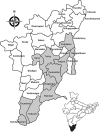Trematode Fluke Procerovum varium as Cause of Ocular Inflammation in Children, South India
- PMID: 26812231
- PMCID: PMC4734527
- DOI: 10.3201/eid2202.150051
Trematode Fluke Procerovum varium as Cause of Ocular Inflammation in Children, South India
Abstract
Trematodes are recognized as a group of emerging parasites in tropical countries. We identified a trematode as a cause of ocular granulomas that developed in children who bathed in ponds or rivers in South India. DNA was isolated from patients' surgically excised granulomas and from the trematode cercariae (larvae) released by the snail Melanoides tuberculata in water in which the children bathed. Real-time and conventional PCRs were performed that targeted ribosomal DNA regions spanning the internal transcribed spacer 2 and 28S sequences of this trematode. The PCR-amplified products were subjected to bidirectional sequencing. Analysis of sequences for the granuloma samples and the trematode cercariae showed maximum sequence similarity with Procerovum varium (family Heterophyidae). Our results confirmed the etiology of the ocular infection, implicating snail vectors as environmental risk factors for ocular parasitosis.
Keywords: India; cercaria; child; eye disease; fresh water; granuloma; lakes; parasites; ponds; real-time PCR; ribosomal DNA; rivers; sequencing; trematode; uveitis.
Figures






Similar articles
-
Characterization of the Life Cycle of a Fish Eye Fluke, Austrodiplostomum ostrowskiae (Digenea: Diplostomidae), with Notes on Two Other Diplostomids Infecting Biomphalaria havanensis (Mollusca: Planorbidae) from Catfish Aquaculture Ponds in Mississippi, USA.J Parasitol. 2016 Apr;102(2):260-74. doi: 10.1645/15-850. Epub 2016 Jan 7. J Parasitol. 2016. PMID: 26741049
-
Presumed trematode-induced granulomatous anterior uveitis: a newly recognized cause of intraocular inflammation in children from south India.Am J Ophthalmol. 2002 Jun;133(6):773-9. doi: 10.1016/s0002-9394(02)01435-6. Am J Ophthalmol. 2002. PMID: 12036668
-
Life cycle stages of heterophyid trematodes in Vietnamese freshwater fishes traced by molecular and morphometric methods.Vet Parasitol. 2009 Mar 9;160(1-2):66-75. doi: 10.1016/j.vetpar.2008.10.088. Epub 2008 Oct 28. Vet Parasitol. 2009. PMID: 19056180
-
Ocular nematode and trematode infections in the developing world.Int Ophthalmol Clin. 2010 Spring;50(2):71-85. doi: 10.1097/IIO.0b013e3181d2d915. Int Ophthalmol Clin. 2010. PMID: 20375863 Review. No abstract available.
-
[Role of gastropods in epidemiology of human parasitic diseases].Wiad Parazytol. 2001;47(1):3-24. Wiad Parazytol. 2001. PMID: 16888946 Review. Polish.
Cited by
-
Morphological and molecular identification of Cryptocotyle lingua metacercariae isolated from Atlantic cod (Gadus morhua) from Danish seas and whiting (Merlangius merlangus) from the English Channel.Parasitol Res. 2021 Oct;120(10):3417-3427. doi: 10.1007/s00436-021-07278-6. Epub 2021 Aug 27. Parasitol Res. 2021. PMID: 34448921 Free PMC article.
-
Water related ocular diseases.Saudi J Ophthalmol. 2018 Jul-Sep;32(3):227-233. doi: 10.1016/j.sjopt.2017.10.009. Epub 2017 Nov 4. Saudi J Ophthalmol. 2018. PMID: 30224888 Free PMC article. Review.
-
Ocular Trematodiasis in Children, Sri Lanka.Emerg Infect Dis. 2023 Apr;29(4):809-813. doi: 10.3201/eid2904.221517. Emerg Infect Dis. 2023. PMID: 36958007 Free PMC article.
-
Argon laser photocoagulation for treatment of presumed trematode-induced granulomatous anterior uveitis in children.Br J Ophthalmol. 2022 Dec;106(12):1667-1671. doi: 10.1136/bjophthalmol-2021-318796. Epub 2021 Jun 18. Br J Ophthalmol. 2022. PMID: 36414261 Free PMC article. Clinical Trial.
-
Management of presumed trematode-induced granulomatous intermediate uveitis.Eye (Lond). 2023 Aug;37(11):2299-2304. doi: 10.1038/s41433-022-02336-4. Epub 2022 Dec 7. Eye (Lond). 2023. PMID: 36477731 Free PMC article.
References
-
- Srivatanakul P, Viyanant V, Kurathong S, Tiwawech D. Enzyme-linked immunosorbent assay for detection of Opisthorchis viverrini infection. Southeast Asian J Trop Med Public Health. 1985;16:234–9. - PubMed
Publication types
MeSH terms
Substances
LinkOut - more resources
Full Text Sources
Other Literature Sources
Research Materials

